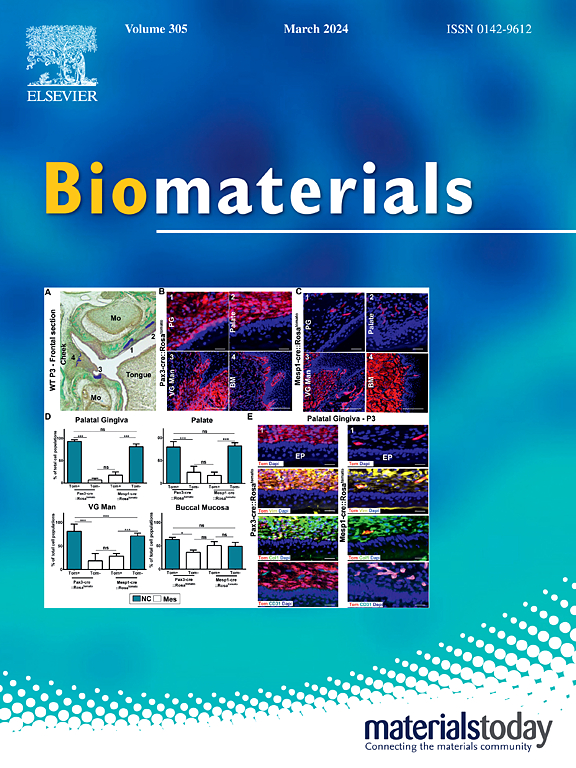Self-assembled copper-amino acid nanoleaves for targeted treatment of deep-seated bacterial infections via chemodynamic therapy and cuproptosis-like death
IF 12.9
1区 医学
Q1 ENGINEERING, BIOMEDICAL
引用次数: 0
Abstract
Transition metal ions such as Cu2+ are promising broad-spectrum bactericidal agents. However, transition metal ions are not used to treat deep-seated bacterial infections in clinic owing to easy deactivation by proteins and lack of targeting ability. Herein, hyaluronic acid (HA)-modified copper-N-acetyl-l-cysteine (NAC) nanoleaves (CNH NLs) are developed to treat deep-seated bacterial infections by targeted delivery of Cu2+ to infection sites. Cu-NAC nanoleaves (CN NLs) can be synthesized by coordinate assembly of Cu2+ and NAC, which are further coated with HA to obtained CNH NLs with targeting ability. CNH NLs are stable in neutral physiological environment, while can be easily decomposed in acidic infection sites, leading to rapid release of Cu2+. The released Cu2+ disrupts bacterial membranes, depletes glutathione, generates reactive oxygen species (ROS), and induces cuproptosis-like bacterial death, exhibiting potent activity against both planktonic bacteria and biofilms. The targeted accumulation and excellent therapeutic efficacy of CNH NLs is further confirmed on murine bacterial keratitis and pneumonia models, highlighting their therapeutic potential for deep-seated infections.
自组装铜氨基酸纳米叶通过化学动力学治疗和铜中毒样死亡靶向治疗深层细菌感染
Cu2+等过渡金属离子是很有前途的广谱杀菌剂。然而,过渡金属离子易被蛋白质失活,缺乏靶向能力,在临床上并未用于治疗深层细菌感染。本研究开发了透明质酸(HA)修饰的铜- n -乙酰-l-半胱氨酸(NAC)纳米叶(CNH NLs),通过靶向递送Cu2+到感染部位来治疗深层细菌感染。通过Cu2+与NAC的配位组装,可以合成Cu-NAC纳米叶(cnnls),并在NAC表面涂覆HA,得到具有靶向能力的CNH NLs。CNH NLs在中性生理环境下稳定,但在酸性感染部位容易分解,导致Cu2+快速释放。释放的Cu2+破坏细菌膜,消耗谷胱甘肽,产生活性氧(ROS),并诱导铜中毒样细菌死亡,对浮游细菌和生物膜都表现出强大的活性。在小鼠细菌性角膜炎和肺炎模型上进一步证实了CNH NLs的靶向蓄积和优异的治疗效果,突出了其治疗深部感染的潜力。
本文章由计算机程序翻译,如有差异,请以英文原文为准。
求助全文
约1分钟内获得全文
求助全文
来源期刊

Biomaterials
工程技术-材料科学:生物材料
CiteScore
26.00
自引率
2.90%
发文量
565
审稿时长
46 days
期刊介绍:
Biomaterials is an international journal covering the science and clinical application of biomaterials. A biomaterial is now defined as a substance that has been engineered to take a form which, alone or as part of a complex system, is used to direct, by control of interactions with components of living systems, the course of any therapeutic or diagnostic procedure. It is the aim of the journal to provide a peer-reviewed forum for the publication of original papers and authoritative review and opinion papers dealing with the most important issues facing the use of biomaterials in clinical practice. The scope of the journal covers the wide range of physical, biological and chemical sciences that underpin the design of biomaterials and the clinical disciplines in which they are used. These sciences include polymer synthesis and characterization, drug and gene vector design, the biology of the host response, immunology and toxicology and self assembly at the nanoscale. Clinical applications include the therapies of medical technology and regenerative medicine in all clinical disciplines, and diagnostic systems that reply on innovative contrast and sensing agents. The journal is relevant to areas such as cancer diagnosis and therapy, implantable devices, drug delivery systems, gene vectors, bionanotechnology and tissue engineering.
 求助内容:
求助内容: 应助结果提醒方式:
应助结果提醒方式:


